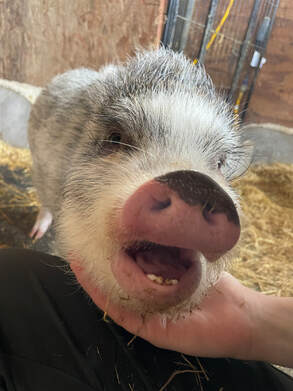|
Nora Bahr UC Davis undergraduate, 4th year Major: Wildlife, Fish, and Conservation Biology Care Bear enjoying some scratches Amid studying for finals, I find myself yearning for more and more time at the ranch. It really does feel like an escape, a place where I can forget about the daily responsibilities of school and the stressors of life and simply exist with and appreciate animals. When I pass the minis on my way to the pig stall, I send a “Good morning!” their way, and all four of them trot up to the gate to greet me back. After giving Memphis copious head scratches, I make my way to the pigs, and as soon as they hear my footsteps they start squealing. Though ear-splitting, it’s a comforting sound because it reminds me of the strong bond Claire and I have built with them. Each pig perks up and oinks at me when I call their name. I could sit and watch them all day. It’s such a joy to know and be known by animals, and I want to share this feeling with as many people as possible. After spending months training the pigs and designing an experiment, we’re getting closer to achieving that goal. Claire and I have been preparing the pigs for our research on therapy animals by training them to be comfortable in a variety of situations. We’ve been working on gradually introducing them to the back of her car where we have a crate in case we ever need to transport them. They’ve been adjusting to this so well; I never would have thought those tiny timid piglets at the beginning of the summer would be able to be comfortably picked up and placed in the back of a vehicle. We’ve also started to introduce them to the round pen here on the ranch as a sort of habituation period for where the experiment will take place. This will definitely be a challenge: the pigs are small enough to squeeze through the gap between the entrance gate and the fine gravel below, so we’ll either have to find a barricade or keep them on leashes for the experiment. They absolutely loved being able to run around such a large space!
As always, I continue to learn more and more each day about the pigs. Their personalities have blossomed. Their learning styles are more apparent than ever: Jelly Bean is quick to learn verbal and hand cues but occasionally is overzealous in her excited state. Care Bear, as timid as she is, is incredibly sharp and no-nonsense when it comes to commands. Romeo is headstrong and stubborn as all get-out, but he’s also a huge sweetheart: he begrudgingly gives in to both verbal and physical cues and cautiously sinks into scratches. If, for whatever reason, you decide to offer scratches to a different pig, he quickly but shyly interrupts, as if to say “I like this but I will never admit it to you.” In addition to training the pigs, we’ve also been working out the details of our experiment. The research project I presented on a few weeks ago (“Temperament test for donkeys to be used in assisted therapy”) centered around testing to determine which of the donkeys in the study would make good therapy animals. Though this was an interesting idea, Claire and I ultimately decided to return to our original experimental design: having one group of people interact with the pigs and another group with zero pig interaction. We then thought: what if we incorporate another positive control group to compare to the pig group results? Our idea is to have one pig therapy group, one dog therapy group (the positive control), and one therapy group with zero animal interaction (negative control). I have learned a lot about my work style in these past few weeks, especially concerning scientific research and writing. When you’re writing a scientific paper, it’s easy to get sucked into a void of information and convince yourself that your study must be more complicated than it has to be. Was my study design too complicated? Too simple? Did I have enough experience under my belt to be qualified enough for this type of writing? These thoughts constantly ran through my mind as I wrote out my experiment. Times like these are when I’m reminded that having a collaborator during the beginning stages of a new project is vital: Claire and I are able to bounce ideas off of each other, motivate each other, and teach each other. Because everything is so nebulous at this stage, I’ve learned that communication about concerns and thoughts is incredibly helpful. In the wise words of Becca Calisi: the simpler the better. We have the location, the basic design, and the animals down. The plan going forward is to flesh out our study design, do some pilot tests with the pigs and members of the lab, and then begin our experiment. By next quarter, we may even be ready to start real trials! I am so excited to see tangible data, to see the pigs working, and to see our hard work paying off. Plus, the pigs will have a brand-new permanent enclosure next year. There are so many things to look forward to and I’m so excited to share them here. Stay tuned!
2 Comments
Leave a Reply. |
Green Care Blog
Here you can find blog posts from each Green Care Lab intern. We'll be talking about our research process, the benefits of Green Care therapy, and sharing pictures of our work. Follow along with us! Authors
All
Archives
July 2023
|

